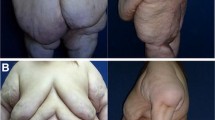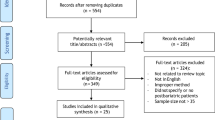Abstract
Background
Currently, many body-contouring patients are overweight or obese or recently have sustained massive weight loss. Often these patients need multiple surgical procedures with extensive incisions. The need for optimal healing in all these patient populations is, however, hampered by their existing nutritional deficiencies.
Methods
Based on the authors’ previous work (Agha-Mohammadi and Hurwitz Plast Reconstr Surg 122:604–618, 2008; Agha-Mohammadi and Hurwitz Plast Reconstr Surg 122:1901–1914, 2008), three clinical studies were initiated. The first study examined the preoperative nutritional parameters of 90 body-contouring patients. Of the 48 postbariatric patients, 38% had low prealbumin (<20 mg/dl), 33% had vitamin A deficiency, 32.6% had low hemoglobin (<12 g/dl), 16.3% had iron deficiency, 9.5% had vitamin B12 deficiency, and 12% had hyperhomocystinemia. Among the 42 nonbariatric patients, only 10% had low prealbumin and 11.5% had vitamin A deficiency. Other deficiencies were less remarkable. The second study evaluated the effect of a surgical nutritional supplement on the prealbumin, vitamin A, vitamin B12, and folate levels of 13 decubitus ulcer patients. The data indicated an increase in all the measured parameters, particularly a prealbumin increase of about 0.8 mg/dl per day. The third study investigated complications experienced by 131 body-contouring patients. The patients were divided into postbariatric and nonbariatric groups, then stratified according to their body mass index (BMI). The rates of minor and major complications in obese nonbariatric and postbariatric patients (receiving the nutritional supplement) were comparable with those of normal-weight nonbariatric patients.
Conclusion
Obese nonbariatric and postbariatric patients are at nutritional risk for many primary ingredients of wound healing and immune system competency. Appropriate nutritional supplementation is an effective means for correcting these nutritional parameters and can significantly reduce surgical complications associated with obesity and bariatric surgery.
Similar content being viewed by others
References
Wang Y, Beydoun MA (2007) The obesity epidemic in the United States—gender, age, socioeconomic, racial/ethnic, and geographic characteristics: a systematic review and meta-regression analysis. Epidemiol Rev 29:6–28
Ogden CL, Carroll MD, Curtin LR et al (2006) Prevalence of overweight and obesity in the United States, 1999–2004. JAMA 295:1549–1555
National Institutes of Health (1998) Clinical guidelines on the identification, evaluation, and treatment of overweight and obesity in adults: the evidence report. Obes Res 6(Suppl 2):51S
Flegal KM, Carroll MD, Odgen CL et al (2002) Prevalence and trends in obesity among US adults 1999–2000. JAMA 288:1723
Hedley AA, Ogden CL, Johnson CL et al (2004) Prevalence of overweight and obesity among US children, adolescents, and adults, 1999–2002. JAMA 291:2847
Allison DB, Fontaine KR, Manson JR (1999) Annual deaths attributable to obesity in the United States. JAMA 282:1530
Wang Y, Beydoun MA, Liang L, Caballero B, Kumanyika SK (2008) Will all Americans become overweight or obese?. Estimating the progression and cost of the U.S. obesity epidemic. Obesity 16:2323–2330
Fisher BL, Schauer P (2002) Medical and surgical options in the treatment of severe obesity. Am J Surg 184:9S
Santry HP, Gillen DL, Lauderdale DS (2005) Trends in bariatric surgical procedures. JAMA 294:1909
Dixon JB, Dixon ME, O’Brien PE (2001) Quality of life after LAP-BAND placement: influence of time, weight loss, and comorbidities. Obes Res 9:713–721
Mamplekou E, Komesidou V, Bissias C et al (2005) Psychological condition and quality of life in patients with morbid obesity before and after surgical weight loss. Obes Surg 15:1177–1184
Dixon JB, Dixon ME, O’Brien PE (2002) Body image: Appearance orientation and evaluation in the severely obese: changes with weight loss. Obes Surg 12:65–71
Sjostrom L, Lindroos AK, Peltonen M et al (2004) Lifestyle, diabetes, and cardiovascular risk factors 10 years after bariatric surgery. N Engl J Med 351:2683–2693
Adams TD, Gress RE, Smith SC et al (2007) Long-term mortality after gastric bypass surgery. N Engl J Med 357:753–761
Peeters A, O’Brien PE, Laurie C et al (2007) Substantial intentional weight loss and mortality in the severely obese. Ann Surg 246:1028–1033
Data obtained from American Society for Metabolic and Bariatric Surgery. www.asbs.org/Newsite07/resources/press_release_8202007.pdf. Accessed 1 Nov 2009
Conference NIH (1991) Gastrointestinal surgery for severe obesity. Consensus Development Conference Panel. Ann Intern Med 115:956–961
American Society of Plastic Surgeons (2006) Procedural Statistics: Body contouring after massive weight loss. www.plasticsurgery.org/media. Accessed 1 Nov 2009
Neaman KC, Hansen JE (2007) Analysis of complications from abdominoplasty: a review of 206 cases at a university hospital. Ann Plast Surg 58:292–298
Janigan DT, Prokopetz RD, Chawla S et al (1989) Massive necrosis of fat and skin as a complication of obesity. CMAJ 140:665–668
Kroll SS, Netscher DT (1989) Complication of TRAM flap breast reconstruction in obese patients. Plast Reconstr Surg 84:886–892
Vastine VL, Morgan RF, Williams GS et al (1999) Wound complications of abdominoplasty in obese patients. Ann Plast Surg 42:34–39
Rogliani M, Silvi E, Labardi L, Maggiulli F, Cervelli V (2006) Obese and nonobese patients: complications of abdominoplasty. Ann Plast Surg 57:336–338
Araco A, Gravante G, Araco F et al (2006) Body contouring after weight loss: the plastic-bariatric surgery symbiosis. Aesthetic Plast Surg 30:374–376
Shermak MA, Chang D, Magnuson TH et al (2006) An outcomes analysis of patients undergoing body contouring surgery after massive weight loss. Plast Reconstr Surg 118:1026–1031
Fraccalvieri M, Datta G et al (2007) Abdominoplasty after weight loss in morbidly obese patients: a 4-year clinical experience. Obes Surg 17:1319–1324
Hurwitz D, Agha-Mohammadi S, Ota K, Unadkat J (2008) A clinical review of total body lift. Aesth Surg J 28:294–304
Greco JA, Castaldo ET, Nanney LB, Wendel JJ, Summitt JB, Kelly KJ et al (2008) The effect of weight loss surgery and body mass index on wound complications after abdominal contouring operations. Ann Plast Surg 61:235–242
Kimmons JE, Blanck HM, Tohill BC, Zhang J, Khan LK (2006) Associations between body mass index and the prevalence of low micronutrient levels among U.S.adults. Med Gen Med 8:59
Kaidar-Person O, Person B, Szomstein S, Rosenthal RJ (2008) Nutritional deficiencies in morbidly obese patients: a new form of malnutrition? Part B: minerals. Obes Surg 18:1028–1034
Agha-Mohammadi S, Hurwitz DJ (2008) Potential impacts of nutritional deficiency of postbariatric patients on body-contouring surgery. Plast Reconstr Surg 122:1901–1914
Agha-Mohammadi S, Hurwitz DJ (2008) Nutritional deficiency of postbariatric surgery body contouring patients: what every plastic surgeon should know. Plast Reconstr Surg 122:604–613
Carrodeguas L, Kaidar-Person O, Szomstein S, Antozzi P, Rosenthal R (2005) Preoperative thiamine deficiency in obese population undergoing laparoscopic bariatric surgery. Surg Obes Relat Dis 1:517–522
Fearon KC, Ljungqvist O, Von Meyenfeldt M et al (2005) Enhanced recovery after surgery: a consensus review of clinical care for patients undergoing colonic resection. Clin Nutr 24:466
Pikul J, Sharpe MD, Lowndes R et al (1994) Degree of preoperative malnutrition is predictive of postoperative morbidity and mortality in liver transplant recipients. Transplantation 57:469
Dempsey DT, Mullen JL, Buzby GP (1998) The link between nutritional status and clinical outcome: can nutritional intervention modify it? Am J Clin Nutr 47:352
Heslin MJ, Latkany L, Leung D et al (1997) A prospective, randomized trial of early enteral feeding after resection of upper gastrointestinal malignancy. Ann Surg 226:567–577
Snyderman CH, Kachman K, Molseed L et al (1999) Reduced postoperative infections with an immune-enhancing nutritional supplement. Laryngoscope 109:915
Braga M, Gianotti L, Vignali A et al (2002) Preoperative oral arginine and omega-3 fatty acid supplementation improves the immunometabolic host response and outcome after colorectal resection for cancer. Surgery 132:805
Tepaske R, Velthuis H, Oudemans-van Straaten HM et al (2001) Effect of preoperative oral immune-enhancing nutritional supplement on patients at high risk of infection after cardiac surgery: a randomised placebo-controlled trial. Lancet 358:696
Gianotti L, Braga M, Nespoli L et al (2002) A randomized controlled trial of preoperative oral supplementation with a specialized diet in patients with gastrointestinal cancer. Gastroenterology 122:1783
Braga M, Gianotti L, Nespoli L et al (2002) Nutritional approach in malnourished surgical patients: a prospective randomized study. Arch Surg 137:174
Ljungqvist O, Nygren J, Thorell A (2002) Modulation of postoperative insulin resistance by preoperative carbohydrate loading. Proc Nutr Soc 61:329
Ljungqvist O, Nygren J, Thorell A et al (2001) Preoperative nutrition elective surgery in the fed or the overnight fasted state. Clin Nutr 20:167
Bloomberg RD, Fleishman A, Nalle JE et al (2005) Nutritional deficiencies following bariatric surgery: what have we learned? Obes Surg 15:145
Madan AK, Orth WS, Tichansky DS, Ternovits CA (2006) Vitamin and trace mineral levels after laparoscopic gastric bypass. Obes Surg 16:603–606
Trostler N, Mann A, Zilberbush N et al (1995) Nutrient intake following vertical banded gastroplasty or gastric bypass. Obes Surg 5:403
Bleiberg-Daniel F, Wade S, Labarre C, Balagny D, Fichelle A, Bory J et al (1985) Variations in plasma thyroxine-binding prealbumin (TBPA) in relation to other circulating proteins in postoperative patients during rapid oral refeeding. Hum Nutr Clin Nutr 39:55–62
Lindstedt E, Sandblom P (1975) Wound healing in man: tensile strength of healing wounds in some patient groups. Ann Surg 181:842–846
Ruberg RL (1984) Role of nutrition in wound healing. Surg Clin North Am 64:705–714
Pinhas-Hamiel O, Doron-Panush N, Reichman B, Nitzan-Kaluski D, Shalitin S, Geva-Lerner L (2006) Obese children and adolescents: a risk group for low vitamin B12 concentration. Arch Pediatr Adolesc Med 160:933–936
Flancbaum L, Belsley S, Drake V, Colarusso T, Tayler E (2006) Preoperative nutritional status of patients undergoing Roux-en-Y gastric bypass for morbid obesity. J Gastrointest Surg 10:1033–1037
Strauss RS (1999) Comparison of serum concentrations of alphatocopherol and beta-carotene in a cross-sectional sample of obese and nonobese children (NHANES III). National Health and Nutrition Examination Survey. J Pediatr 134:160–165
Acknowledgment
We thank Shayna Cope, Brooke Brietenbach, and Sarah Johnson for their help in reviewing patients’ charts and gathering and tabulating laboratory data.
Author information
Authors and Affiliations
Corresponding author
Rights and permissions
About this article
Cite this article
Agha-Mohammadi, S., Hurwitz, D.J. Enhanced Recovery After Body-Contouring Surgery: Reducing Surgical Complication Rates by Optimizing Nutrition. Aesth Plast Surg 34, 617–625 (2010). https://doi.org/10.1007/s00266-010-9522-x
Received:
Accepted:
Published:
Issue Date:
DOI: https://doi.org/10.1007/s00266-010-9522-x




